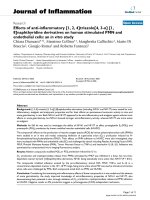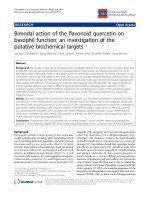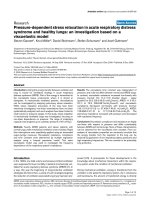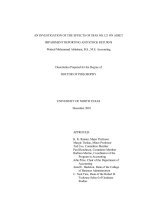Intake manifold design effect on air fuel mixing and flow for an LPG heavy duty engine
Bạn đang xem bản rút gọn của tài liệu. Xem và tải ngay bản đầy đủ của tài liệu tại đây (533.54 KB, 12 trang )
INTERNATIONAL JOURNAL OF
ENERGY AND ENVIRONMENT
Volume 3, Issue 1, 2012 pp.61-72
Journal homepage: www.IJEE.IEEFoundation.org
Intake manifold design effect on air fuel mixing and flow for
an LPG heavy duty engine
M. A. Jemni, G. Kantchev, M. S. Abid
University of Sfax, National School of Engineers of Sfax (ENIS), Laboratory of Electro-Mechanic
Systems (LASEM), B.P. 1173, km 3.5 Soukra, 3038 Sfax, TUNISIA.
Abstract
The paper presents an investigation of mixture preparation in the intake manifold of a Diesel converted
engine into LPG spark-ignition engine operation. The formation process of air-LPG (liquefied petroleum
gas) mixture was studied using computation fluid dynamics (CFD) mode. Two manifold shapes are used
in order to test the adequate design in view of flow and air-gas homogenization. The first is designed
according the acoustic-wave-filling phenomena, and the second present an unspecified design. The
model of simulation is based on solving Navier-Stokes and energy equations in conjunction with the
standard k-ε turbulence model, using the 3D CFD code FloWorks. Experiment test are carried out also to
test the intake manifold effect on engine performance. Air-fuel ratio and specific fuel consumption are
determined. The results indicate the effectiveness of the first manifold.
Copyright © 2012 International Energy and Environment Foundation - All rights reserved.
Keywords: Air-LPG mixture; Intake manifold; CFD; Experiment.
1. Introduction
Increasingly stringent legislation aimed at reducing pollutant emissions from vehicles has intensified
efforts to gain better understanding of the various processes involved in internal combustion (IC)
engines. In the case of spark-ignition engines (SI), one of the most important processes is the preparation
of the air-fuel mixture [1]. This mixture circulates to the intake port through a very complicated path
including the air cleaner, intake pipe, and intake manifold. Hence, the design of the intake manifold is an
important factor which determines the engine performance. An intake manifold is one of the primary
components regarding the performance of an internal combustion engine. An intake manifold is usually
made up of a plenum, throttle body connected to the plenum and runners depending on the number of
cylinders, which leads to the engine cylinder [2].
In order to understand the flow characteristics inside the intake manifold, many researches has been
carried out. Zhao [3] studied the development of a comprehensive engine simulation tool that could
predict unsteady flow features in the engine manifold and gas dynamic interaction between the intake
system and the engine. Pogorevc [4] has discussed the design procedure of a cheap multipoint injection
intake system, adapted to a racing car engine using numerical and experimental ways. The flow and the
pressure loss reduction in the engine intake region were investigated. His experimental results confirmed
numerical predictions. Ceviz [5] has performed investigates the effects of intake plenum length/volume
on the performance characteristics of a spark-ignited engine with electronically controlled fuel injectors.
According to his test results, plenum length must be extended for low engine speeds and shortened as the
ISSN 2076-2895 (Print), ISSN 2076-2909 (Online) ©2012 International Energy & Environment Foundation. All rights reserved.
62
International Journal of Energy and Environment (IJEE), Volume 3, Issue 1, 2012, pp.61-72
engine speed increases. Sulaiman et al. [6] have studied the flow characteristics of air flowing in various
designs of air-intake manifold of a 200-cc four-stroke engine Go- Kart engine. The study is done by three
dimensional simulations of the flow. Simulations are validated by an experimental study. From this
study, they reveal that the variations in the geometry of the air- intake system can result in a difference of
up to 20% in the mass flow rate of air entering the combustion chamber.
Harrison [7] is interested in the description of a linear acoustic model that has proven useful in obtaining
a better understanding of the nature of acoustic wave dynamics in the intake system of an internal
combustion engine. The model has proved in identifying the role of pipe resonance in the intake process
and the importance of acoustic waves in the engine supercharging and filling. Lee [8] has developed a
computer program to predict the engine performance characteristics through the analysis of the flow in
the intake and exhaust systems and of the cylinder combustion phenomena for the MPI spark ignition
engines. The result of simulation has been compared with that of experimental test in order to identify
the optimal design of intake manifold.
The motion of fluid and the behavior of air-fuel mixture inside the intake manifold are very complex and
very difficult to pinpoint. Nowadays, computational fluid dynamics (CFD) simulation helps in adapting
engine part design, saving time and money. CFD is widely used in the design and modeling of the
internal combustion engine especially for the intake flow modeling [9-14]. The inlet aerodynamic
process was often studied through the experiment, especially with the techniques development of fluid
visualization optical methods based on particles images velocimetry [15-17].
However, the analysis of the air-fuel mixture nature through the intake manifold is rarely studied,
especially for heavy duty engine. In this paper, a numerical simulation of the flow and air gas mixing
fields is achieved through two intake manifold designs, using the CFD code FloWorks. The test engine is
an IVECO urban bus engine. This engine has been converted from its Diesel version into a gaseous
fueling spark ignition (gasoline-gas bi-fuel) version. The gas using is the LPG alternative fuel, because of
its various advantages [18]. Accordingly, the three-dimensional resolution of Navier-Stokes equations in
conjunction with the standard k-ε turbulence model is undertaken to provide knowledge of the air gas
movement nature and examining the intake manifold optimal geometry. Experiments tests are carried out
also to identify the manifold design effect on engine behavior. Air-fuel ratio and specific fuel
consumption are determined.
2. Engines manifolds studied models
The studied model is a Diesel engine converted into bi-fuel gasoline-LPG type IVECO. Its main
characteristics are presented in Table 1. For this current study, two designs of manifold (Figure 1) were
considered to study the flow and air gas mixture behavior. To design an optimal intake manifold,
following parameters should be taken into consideration. 1- Uniform distribution of mixture to all
cylinders. 2- Minimum possible resistance in runners. 3- To provide as direct a flow as possible to each
cylinder, 4- To assist fuel atomization and vaporization. 5- To provide equal aspiration intervals between
the branch pipes. Two different manifold geometries were considerate. Geometry 1 consists of a limited
volume plenum connecting directly with six runners. The runner’s lengths are determined according
phenomena of the acoustic waves propagation in intake manifold. It supports the cylinder filling and the
engine volumetric efficiency if it is properly exploited [19]. This manifold called ‘optimized intake
manifold’ in the rest on text. The secondary geometry, consist of runners coupled to cylinders through a
high volume plenum.
3. Computational methodology
Intake manifold is designed to provide fresh air or mixture to internal combustion engines. The gas
circulation in plenum and runners causes very varied structures of turbulence. As a result; there is
creation of unstable mixtures between air and fuel (rich or lean mixture). So far, this research aims at the
3D numerical analysis of flow in two manifold geometries using a CFD code. FloWorks is chosen for its
capabilities flow analysis for both in gas and liquid simultaneously.
3.1 3D geometries model of manifolds
In this paper the commonly available CFD tool FloWorks is applied. FloWorks has the advantages of
importing geometry directly from a CAD program such as SolidWorks (SW). At the beginning, the 3D
geometries construct of intake manifolds are built by the CAD software SW; as shown in Figure 2. The
files created by SW are imported into FloWorks to build mesh for final simulation calculation.
ISSN 2076-2895 (Print), ISSN 2076-2909 (Online) ©2012 International Energy & Environment Foundation. All rights reserved.
International Journal of Energy and Environment (IJEE), Volume 3, Issue 1, 2012, pp.61-72
63
Table 1. Characteristics of the IVECO engine
Engine parameters
Engine (four cycle)
Reference
Type
Bore × Stroke (mm)
Displacement (dm3)
rod length (mm)
Crank radius (mm)
Compression ratio
Engine speed range (rpm)
Cooling system
Firing order
Value
IVECO
8210.02
6 Cylinders – Inline
137 x 156
13.8
260
78
16:1 (Diesel), 12 : 1 (LPG)
700 - 2000
Water cooling
1-5-3-6-2-4
3.2 Governing equations
The governing equations of gas dynamics are expressions of the law of conservation and the laws of
thermodynamics. The manifolds simulation is based on the 3D unsteady turbulence flow model. In the
3D manifolds model, air-fuel mixture is defined as compressible fluid. The standard k-ε model is utilized
to solve the flow problem inside the manifolds. FloWorks solves the Navier-Stokes equations, which are
formulations of mass, momentum and energy conservation laws for fluid flows in conjunction with the kε model equations:
∂ρ ∂
+
( ρ ui ) = 0
∂t ∂xi
(1)
∂
∂
∂p
∂
( ρ ui ) + ( ρ ui u j ) + = (τ ij + τ ijR ) + Si ; i = 1, 2,3
∂t
∂xi
∂xi ∂xi
(2)
⎛
p⎞
∂ρ ui ⎜ E + ⎟
ρ⎠ ∂
∂u
∂ρ E
⎝
u j (τ ij + τ ijR ) + qi − τ ijR i + ρε + Si ui + QH
+
=
∂t
∂xi
∂xi
∂x j
(
E = e+
u2
.
2
)
(3)
(4)
where ‘ρ’ is the density, ‘u’ is the velocity, ‘p’ is the pressure, ‘Si’ is a mass-distributed external force per
unit mass, ‘e’ is the internal energy, ‘QH’ is a heat source or sink per unit volume, ‘τij’ is the viscous
shear stress tensor, “qi” is the diffusive heat flux.
The mixture density is calculated by [20]:
m propane
1
ρ
=
mair
×
1
ρ propane
m propane
mair
+
1
ρ air
(5)
+1
The turbulent viscosity is given by:
µ t = Cµ ρ
k2
ε
(6)
This viscosity is a function of the turbulent kinetic energy ‘k’ and its dissipation rate ‘ε’. The equations of
turbulent kinetic energy and its dissipation rate are written as:
ISSN 2076-2895 (Print), ISSN 2076-2909 (Online) ©2012 International Energy & Environment Foundation. All rights reserved.
64
International Journal of Energy and Environment (IJEE), Volume 3, Issue 1, 2012, pp.61-72
∂ρ k ∂
∂
+
( ρui k ) =
∂t ∂xi
∂xi
⎛⎛
µt
⎜⎜ ⎜ µ +
σk
⎝⎝
⎞ ∂k
⎟
⎠ ∂xi
⎞
∂ui
− ρε + µt PB
⎟⎟ + τ ij
∂x j
⎠
(7)
∂ρε ∂
∂
+
( ρuiε ) =
∂t ∂xi
∂xi
⎛⎛
µt
⎜⎜ ⎜ µ +
σε
⎝⎝
⎞ ∂ε
⎟
⎠ ∂xi
⎞
⎞
∂ui
ε⎛
ρε 2
+ µt CB PB ⎟ − Cε 2 f 2
⎟⎟ + Cε 1 ⎜⎜ f1τ ij
⎟
k⎝
k
∂x j
⎠
⎠
(8)
‘PB’ represents the turbulent generation due to buoyancy forces, “CB” is defined as: CB = 1 when PB > 0,
and 0 otherwise.
⎛ 0.05 ⎞
f1 = 1 + ⎜
⎜ f ⎟⎟
⎝ µ ⎠
3
, f2 = 1 − e
⎛ ⎛ 2 ⎞2 ⎞
⎜ −⎜ ρ k ⎟ ⎟
⎜ ⎜ µε ⎟ ⎟
⎠ ⎠
⎝ ⎝
(9)
Cε 1 = 1, 44 ; Cε 2 = 1,92 ; Cε 3 = −1 ; Prk = 1 ; Prε = 1,3 , and Cµ = 0, 09 , are the constants of the standard
model (k, ε).
3.3 Boundary conditions for the manifolds models
Simulation tests are carried out in the intake stroke for a crank angle equal to 130°. To simplify the
calculations, the manifold and the cylinder walls are assumed adiabatic: no transfer of heat with outside.
The simulation is performed for the engine speed correspond to the maximum torque (n=1500 rpm) and
only the first cylinder in aspiration. Two fluids are used, air and propane (we took a composition of LPG
formed almost fully with propane). The inlet intake manifold pressure is taken as an initial condition; it is
equal to 1.013 bar for the air inlet and 1.5 bar for the propane inlet. The alternative piston speed along the
intake stroke is taken as final condition. The piston speed is taken equal to 3.55 m/s. This value is
depends on parameters of the engine crank rod system.
3.4 Computational meshing
Flow Simulation computational mesh is rectangular everywhere in the computational domain, so the
mesh cells’ sides are orthogonal to the specified axes of the Cartesian coordinate system and aren’t fitted
to the solid/fluid interface. As a result, the solid/fluid interface cuts the near-wall mesh cells.
Nevertheless, due to special measures, the mass is treated properly in these cells named partial. The
rectangular computational domain is automatically constructed, so it encloses the solid body and has the
boundary planes orthogonal to the specified axes of the Cartesian coordinate system. Then, the
computational mesh is constructed in the following several stages; constriction of basic mesh, capture the
solid/fluid interface and refinement the solid/fluid interface mesh.
The meshes are defined with the total number of 22632 for the optimized intake manifold (the half of this
manifold is meshed view its decomposition into two symmetric parts), and 40684 for the second
manifold, see Figure 1.
3.5 CFD results
Velocity field is presented during the intake stroke. The control of velocity distribution in the combustion
chamber improves flame quality and returns an economical air-fuel mixture. Figure 2 shows the 3D
velocity distribution for the two manifolds. Gas blend is drawn by the downward motion of the piston.
The air propane mixture is spreading in the cylinder, interacts with cylinder walls. When the flow reaches
the combustion inlet valve, it undergoes an acceleration considering the valve restriction surface. For the
optimized manifold the mixture velocity is nearly equal to 81 m/s passing through the valve and
decreases less than 25 m/s, such velocity supports filling. Whereas, this isn’t the case in the second
manifold, 70 m/s and decrease below 16 m/s. This difference shows the manifold geometry influence on
mixture velocity. In runners, a velocity discontinuity is noticed in the second manifold. Its origin is the
presence of several dead zones in the geometry.
ISSN 2076-2895 (Print), ISSN 2076-2909 (Online) ©2012 International Energy & Environment Foundation. All rights reserved.
International Journal of Energy and Environment (IJEE), Volume 3, Issue 1, 2012, pp.61-72
65
(a) Optimized intake manifold
(b) Second intake manifold
Figure 1. 3D Model of intake manifolds
ISSN 2076-2895 (Print), ISSN 2076-2909 (Online) ©2012 International Energy & Environment Foundation. All rights reserved.
66
International Journal of Energy and Environment (IJEE), Volume 3, Issue 1, 2012, pp.61-72
(a) Optimized intake manifold
(b) Second intake manifold
Figure 2. Velocity field
ISSN 2076-2895 (Print), ISSN 2076-2909 (Online) ©2012 International Energy & Environment Foundation. All rights reserved.
International Journal of Energy and Environment (IJEE), Volume 3, Issue 1, 2012, pp.61-72
67
The 3D propane mass fraction is presented in Figure 3 for the two manifolds. As shown in this figure, the
mixture is basically lean in the inlet of manifolds on account to the entering air acceleration. Air-gas
mixing process in LPG fueled engine can be divided into three continuous areas: manifolds inlet,
manifolds runners and inside cylinder. In the first area, the flow is unstable view the incompatibility of
air and propane molecules speed. In the second area, the blend was expanded (the flow instability
persists in the second manifold especially at the plenum). In the third area, the mixture homogeneity
appears clearer. Inside the engine cylinder, for the first manifold design, the means propane-air ratio is
0.07 which is near the equivalent propane-air ratio (0.065); the stoichiometric ratio (SR) is 15.5 for LPG
engine [18]. In the second, the ratio is a round of 0.05. Mixing of fuel was more at high speeds in the first
manifold; the propane friction shows this mixing. The fluid trajectory lines support the influence of the
manifold design configuration on the overall flow in the cylinder. In the non optimized manifold, these
lines present stirring motions that hinder the flow and cylinder filling. When entering inside the cylinder,
the fluid trajectories, in the optimized manifold, form circulating swirl movements, which further
enhances filling and the combustion process.
As a conclusion, the distributions of the velocity fields and the air fuel friction are strongly depending on
the intake manifold geometry.
4. Experimental validation
To validate the numerical simulation work, an engine test, presented in Figure 4 is plugged with the two
intake manifold geometries. This engine is converted from its original Diesel version into LPG gaseous
fueling. Its features are summarized in table 1. The air gas ratio and the specific fuel consumption of the
engine are measured for the two manifolds versions. These engine performances are determined using
LPG.
The engine was mounted on a test bench and connected with a hydraulic dynamometer brake type "H3
BIS" in order to measure power and torque. The quantity of consumed fuel is measured using a mass
flow meter type “Kroohne Optimass MFC 050. The air flow is measured by Differential pressure flow
meter. Engine speed is measured by an optical tachometer type “Chauvinistic Arnoux CA 27”.
The air-fuel ratio (AFR) is showed in Figure 5. The evolution of air-gas ratio shows an increase if the
engine speed is increased for both manifolds. The highest of the ratio is 15.1 for the optimized manifold
on engine speed 1400 rpm and its lowest is 11.8 on 600 rpm, however, it is in the range of (11, 14.8) for
the second manifold. It is notable that the engine runs rich mixtures, especially in the starting speeds. The
ratio average difference between the two manifolds is equal to 7.1 %. At 1400 rpm, the mixture nature is
almost near of the air LPG stoichiometric ratio (15.5 for LPG engines) for the optimized intake manifold
operation. This advantage is due to the homogenization optimize of the mixture in this manifold
especially with the loss reduction due to its design.
Figure 5 presents also the evolution of the specific fuel consumption (SFC) for the two manifolds. It can
be seen that the SFC for both manifolds decrease gradually when the engine speed is increased. The fuel
consumption for the optimized manifold is greater than the second. On an average basis, the first intake
manifold operation reduces the specific fuel consumption by 28 % for all the engine speeds tested. This
reducing is explained by the in-cylinder filling growth and the proper mixture homogenization, which is
attached to reduced charge losses.
ISSN 2076-2895 (Print), ISSN 2076-2909 (Online) ©2012 International Energy & Environment Foundation. All rights reserved.
68
International Journal of Energy and Environment (IJEE), Volume 3, Issue 1, 2012, pp.61-72
(a) Optimized intake manifold
(b) Second intake manifold
Figure 3. Propane mass fraction field
ISSN 2076-2895 (Print), ISSN 2076-2909 (Online) ©2012 International Energy & Environment Foundation. All rights reserved.
International Journal of Energy and Environment (IJEE), Volume 3, Issue 1, 2012, pp.61-72
69
3
4
2
1
1
(a) Optimized intake manifold
(b) Second intake manifold
Figure 4. Manifolds disposition on the engine test
1-Intake manifolds, 2-LPG vapo-regulator, 3-Fuel flow meter, 4-LPG pipes
Figure 5. Intake manifold effect on air-LPG ratio and SFC
5. Conclusion
The main conclusions we can draw from this paper are the following:
1- The analysis of the flow and mixture motion features, during the intake stroke, is numerically made by
a CFD code. The numerical study made it possible to select the optimized intake system geometry.
2- Velocity field and propane mass concentration are investigated in this simulation. Results affirm the
effectiveness of the manifold which designed according the acoustic-wave-filling phenomena.
3- Experiment tests were performed in order to study the intake manifold influence on the engine
performance. The air-fuel ratio and the specific fuel consumption are measured and determined. With the
optimized manifold, both AFR and SFC are improved by 7 % and 28 % respectively.
ISSN 2076-2895 (Print), ISSN 2076-2909 (Online) ©2012 International Energy & Environment Foundation. All rights reserved.
70
International Journal of Energy and Environment (IJEE), Volume 3, Issue 1, 2012, pp.61-72
4- Numerical and experiments results show the great impact of the intake manifold on the fuel mixture
formation.
Acknowledgements
This project was supported by Regional Transport Company of Sfax (SORETRAS), National School of
Engineers of Sfax (ENIS), ANME and SAGAZ. Authors would like to acknowledge them for their
efforts and helpful technical and financial assistance.
References
[1] Shankar K. S, Mohanan P. MPFI gasoline engine combustion, performance and emission
characteristics with LPG injection. INTERNATIONAL JOURNAL OF ENERGY AND
ENVIRONMENT. Volume 2, Issue 4, 2011 pp.761-770.
[2] Heywood J.B. Internal combustion engine fundamentals. McGraw-Hill Inc, 1988.
[3] Zhao Y., D E Winterbone. A study of multi-dimensional gas flow in engine manifolds, Proc
IMechE Vol 208, 1994.
[4] Pogorevc P. and B Kegl. Intake system design procedure for engines with special requirements,
Proc. IMechE Vol. 220 Part D: J. Automobile Engineering, 2006.
[5] Ceviz M.A., M. Akın. (2010): Design of a new SI engine intake manifold with variable length
plenum, Energy Conversion and Management 51 (2010) 2239–2244.
[6] Sulaiman S. A., S. H. M. Murad, I. Ibrahim and Z. A. Abdul Karim, STUDY OF FLOW IN AIRINTAKE SYSTEM FOR A SINGLE-CYLINDER GO-KART ENGINE. International Journal of
Automotive and Mechanical Engineering (IJAME), Volume 1, pp. 91-104, 2010.
[7] Harrison M.F., P.T. Stanev. A linear acoustic model for intake wave dynamics in IC engines,
Journal of Sound and Vibration 269 (2004) 361–387.
[8] Jae-soon Lee and Keon-Sik Yoon. A Numerical and Experimental Study on the Optimal Design
for the Intake System of the MPI Spark Ignition Engines, KSME Journal, Vol. 10, No. 4, pp. 471479, 1996.
[9] Safari, M., Ghamari, M. and Nasiritosi, A. Intake manifold optimization by using 3-D CFD
analysis, SAE 2003, 32-0073.
[10] Jemni M. A., G. Kantchev, M. S. Abid. A Diesel Engine converted to a Gasoline-Natural Gas BiFuel System: Optimization of the Intake manifold system Using CFD Analysis, International
Journal of Engineering Simulation (IJES), Vol 11, Number 3, 2010.
[11] Fuchs T. R and C. J. Rutland. Intake Flow Effects on Combustion and Emissions in a Diesel
Engine, SAE N° 980508, 1998.
[12] Ugur Kesgin, Study on the design of inlet and exhaust system of a stationary internal combustion
engine, Energy Conversion and Management 46 (2005) 2258–2287.
[13] Trigui N., V. Griaznov, H. Affes and D. Smith. CFD Based Shape Optimization of IC Engine. Oil
& Gas Science and Technology - Rev. IFP, Vol. 54 (1999), No. 2, pp. 297-307.
[14] Arash Nemati, Shahram Khalilarya, Samad Jafarmadar, Hassan Khatamnejhad, Vahid Fathi.
Numerical parametric investigation of a gasoline fuelled partially-premixed compression-ignition
engine. INTERNATIONAL JOURNAL OF ENERGY AND ENVIRONMENT. Volume 2, Issue
4, 2011 pp.739-748.
[15] Huanga R. F., C.W. Huanga, S.B. Changa, H.S. Yanga, T.W. Lina, W.Y. Hsub. Topological flow
evolutions in cylinder of a motored engine during intake and compression strokes, Journal of
Fluids and Structures 20 (2005) 105–127.
[16] Phil Stansfield, Graham Wigley, Tim Justham, Julian Catto, Graham Pitcher. PIV analysis of incylinder flow structures over a range of realistic engine speeds, Exp Fluids, 43 (2007) 135–146.
[17] Suk-Young Lee, Ku-Seob Jeong, Chung-Hwan aeon, Young-June Chang. A study on the
Characteristics of In-Cylinder Intake Flow in Spark Ignition Engine Using the PIV, Journal of
Mechamcal Scwnce and Technology, Vol 19, No 2, pp. 704- 715, 2005.
[18] Seshaiah. N. Efficiency and exhaust gas analysis of variable compression ratio spark ignition
engine fuelled with alternative fuels. INTERNATIONAL JOURNAL OF ENERGY AND
ENVIRONMENT. Volume 1, Issue 5, 2010 pp.861-870.
[19] Winterbone D. E., Richard J. Pearson. Theory of engine manifold design: wave action methods
for IC engines. Wiley, 2000.
ISSN 2076-2895 (Print), ISSN 2076-2909 (Online) ©2012 International Energy & Environment Foundation. All rights reserved.
International Journal of Energy and Environment (IJEE), Volume 3, Issue 1, 2012, pp.61-72
71
[20] Jean-Claude Guibet. Fuels and engines: technology, energy, environment, Volume 2, editions
Technip, Paris, 1997.
M. A. Jemni born in Sfax Tunisia, Mars 1983. He received his engineering Degree in 2007 in electromechanic from National School of Engineers of Sfax (ENIS), Sfax University, TUNISIA, and received
his MS Degree in 2008 in mechanic and energy engineering from the National School of Engineers of
Sfax. He is pursuing for his PhD Degree in energy engineering and engine researches of ENIS,
TUNISIA. His work covers topics in converting conventional engines into renewable energy for urban
transport. Mr. Jemni is the author of 2 published articles.
E-mail address: , or
G. Kantchev received his engineering Degree in mechanic from Technical University of Sofia (TUS),
Bulgaria. He received from TUS his PhD in 1986. He taught in TUS From 1970 to 1992. Currently, Dr.
Kantchev is working in Mechanical Engineering Department at National School of Engineers of Sfax
since 1992. He is interested in Mechanical Design, Energy, Machines Thermal, and Renewable Energy.
Mr. Kantchev is an author of over 50 articles and Patents.
E-mail address:
M.S. Abid born in Sfax Tunisia, October 1956. He received from Institute Polytechnique of Toulouse
INPT France, his Bachelor degree in chemical engineering in 1981, his Doctor-engineer in 1984 and his
PhD in chemical engineering in 1988. He is interested in Computational Fluid Dynamics CFD and
energy. He is author of different articles published in International Journal Chemical and Mechanical
Engineering. Currently, Dr. Abid is Professor of Mechanical Engineering at National School of
Engineers of Sfax. He is a head of the Laboratory of Electromechanical Systems at Sfax.
E-mail address:
ISSN 2076-2895 (Print), ISSN 2076-2909 (Online) ©2012 International Energy & Environment Foundation. All rights reserved.
72
International Journal of Energy and Environment (IJEE), Volume 3, Issue 1, 2012, pp.61-72
ISSN 2076-2895 (Print), ISSN 2076-2909 (Online) ©2012 International Energy & Environment Foundation. All rights reserved.









